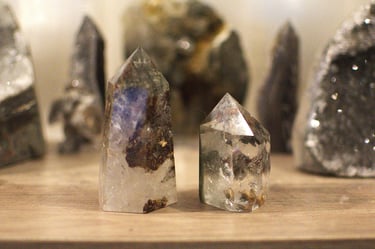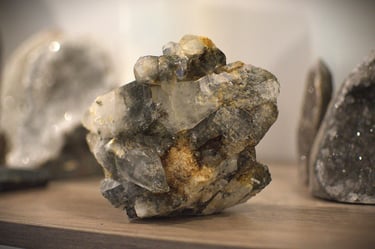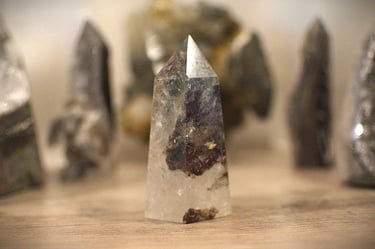Garden Quartz
Healing, Grounding, Emotional Balance, Transformation, Spiritual Growth, Protection, Connection With Nature, Accessing Spiritual Insights
Metaphysical Properties:
Garden Quartz is often sold as Landscape Quartz or Lodolite, assisting in emotional healing, accessing deep-rooted emotions, past life experiences, and spiritual insights.
Symbolism & Associations:
Symbolizes growth, vitality, and connection to the Earth and nature. Its inclusions represent new beginnings and transformations. A powerful stone for self-discovery, as it is believed to help one reconnect with their spiritual path and cultivate resilience.
Chakra Alignment:
Primarily aligned with the Root and Heart Chakras. Its grounding energy helps establish stability, while its soothing inclusions support emotional healing and openness to love.
Planets:
Venus, Mars
Zodiacs:
Taurus, Capricorn
Elements:
Earth, Water
Similar Stones:
Moss Agate, Tree Agate, Jasper, Green Rutile Quartz, Rutilated Quartz
Correspondences:
Colours: Clear, smoky, brown, green, red, yellow
Crystals: Moss Agate, Rose Quartz
Flowers: Daffodils, Sunflowers, Lavender
Herbs: Sage, Lavender, Cedarwood
Essential Oils: Lavender, Sandalwood, Bergamot
Incense: Cedarwood, Frankincense, Sandalwood
Metals: Copper, Silver
Months, Days, & Seasons: March, November, Tuesday, Saturday, Spring, Autumn
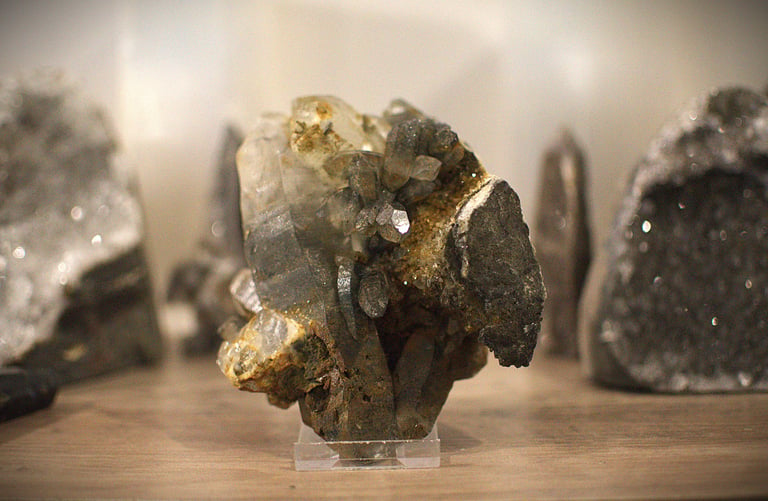


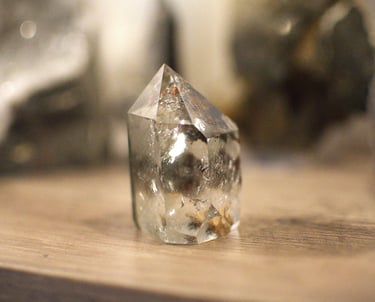
Facts
Stone Type:
Quartz with mineral inclusions, often from chlorite, iron, or other minerals, creating landscape-like or mossy inclusions.
Hardness Rating:
7 on the Mohs scale, so relatively hard and durable, however, can be more fragile due to inclusions.
Chemical Formula:
SiO₂ (Silicon Dioxide)
Care Guide
Garden Quartz is relatively low-maintenance but should be handled carefully to prevent damage to the inclusions. It should not be exposed to harsh chemicals or extreme temperatures, as this can weaken the structure. Regular cleansing with water and charging under the moonlight will help keep its energies vibrant.
Spiritual
Garden Quartz is widely used in healing practices, particularly for grounding and emotional balance. It is often employed in rituals aimed at releasing old emotional baggage and facilitating personal transformation. The stone’s landscape-like inclusions are seen as a reflection of one’s journey, offering guidance and clarity along the path of self-improvement.
Healing
Garden Quartz is believed to support detoxification, improve circulation, stimulate the immune system, and aid pain relief. It may enhance recovery from illness, promote digestive health, and restore balance and vitality. It’s a useful complement to medical treatments for physical healing.
Cleansing
Garden Quartz can be cleansed by placing it in a bowl of water with sea salt or by using sound vibrations from a tuning fork. It is best to avoid exposing it to harsh chemicals or prolonged direct sunlight, as it could cause damage to the inclusions.
Affirmations
"I am grounded, and I embrace emotional balance in my life."
"I release all that no longer serves me, making space for healing and growth."
"I trust in the natural flow of transformation within me."
"I connect with the Earth’s energy to find peace, strength, and renewal."
Meditation
During meditation, hold a piece of Garden Quartz and focus on the inclusions, visualising them as vibrant landscapes. Picture yourself walking through this garden, releasing any emotional burdens and embracing growth and renewal with each step. The stone’s energy is said to help in deepening the meditative state and connecting to higher levels of consciousness.
Astrology
Garden Quartz is particularly beneficial for those under the influence of Taurus and Capricorn, as it enhances their grounding energy and supports personal growth. It also complements Venus and Mars, harmonising both the feminine and masculine energies within.
Vibration
Garden Quartz has a soothing and grounding vibration that resonates deeply with the Root Chakra, helping to anchor the user in the present moment. Its energy promotes emotional balance and healing, while simultaneously allowing for a deeper connection to the Earth and nature.
Did You Know:
Garden Quartz is not just admired for its beauty; it is believed to have a strong connection to the natural world. The inclusions within each piece are often likened to miniature ecosystems, representing the interconnectedness of all life forms. Some metaphysical practitioners use Garden Quartz to help establish a stronger connection to the Earth and nature.
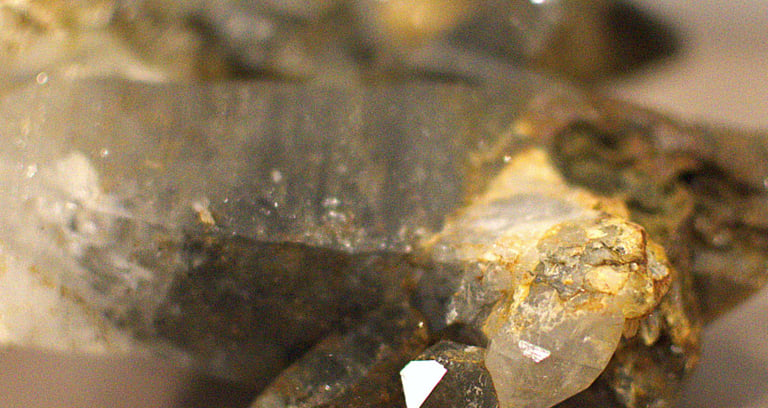

Mythology & Folklore
Garden Quartz, also known as Lodolite or Inclusion Quartz, holds significant spiritual and symbolic meaning across various cultures, linked to themes of nature, transformation, and personal growth. Its unique appearance, with inclusions resembling small landscapes or gardens, connects it deeply with Earth energy. The inclusion patterns are often thought to represent life’s continual cycles, and the stone is believed to be an embodiment of the Earth’s rejuvenating power.
The name Lodolite is derived from the Greek word lodon, meaning “mud,” referencing the earthy, often moss-like inclusions that are part of the crystal’s beauty. In ancient times, stones like Lodolite were seen as physical manifestations of sacred natural elements, believed to channel the Earth’s energies and act as a conduit to higher spiritual realms. Its connection to the Earth’s elemental forces links it to Gaia, the Greek goddess of the Earth, symbolising fertility, protection, and grounding.
Garden Quartz is seen as a stone of transformation. The inclusions within the crystal symbolise growth, making it a powerful tool for healing and personal development. It is thought to nurture the spirit and mind, offering support during times of change and helping to foster new beginnings, ideas, and relationships. This stone’s healing energy is typically viewed as a reminder to care for oneself during times of emotional upheaval or growth.
In folklore, Garden Quartz has been revered for its protective properties. Ancient cultures used it to guard against negative energies and psychic attacks, believing that it could shield and purify one's environment. Additionally, the stone was thought to promote emotional balance, calmness, and clarity, often used in meditation practices to support connection with the Earth and the cosmos.
Garden Quartz also holds significance in terms of its connection to the subconscious mind. With its grounding and healing energy, it has been used in rituals to access deep spiritual wisdom, guide introspection, and encourage psychic abilities. Today, practitioners continue to use Garden Quartz in metaphysical practices, relying on its energy to clear blocked emotions, ease mental strain, and foster spiritual awakening.
Its symbolic connection to growth, protection, and transformation makes Garden Quartz a revered stone for personal and spiritual development, guiding those who seek clarity, balance, and a deeper connection with the Earth and their inner selves.
Historical Significance
Lodolite, also known as Garden Quartz, is a variety of quartz that has emerged as a prominent metaphysical tool in recent years, though its history may not be as well documented as other gemstones. Despite this, its use in crystal healing and spiritual practices follows the broader traditions of quartz in ancient civilizations. It is believed that the stone’s unique appearance—translucent with mineral inclusions resembling gardens or landscapes—was appreciated for its symbolic connection to nature, growth, and transformation.
In ancient cultures, quartz was revered as a sacred stone, often associated with spiritual power, clarity, and connection to the divine. While there are no explicit records of Lodolite being used in ancient civilizations, the qualities of Garden Quartz align with the broader significance of quartz. Ancient Egyptians, for example, were known to use quartz for its purifying properties, and Lodolite's connection to the Earth could have made it highly valued in rituals aimed at maintaining harmony with nature.
In many cultures, the inclusion of natural elements within stones, such as the “gardens” seen in Lodolite, would have been interpreted as representations of the Earth’s wisdom. Ancient civilizations typically viewed these stones as having the power to ground the spirit, connect individuals to natural energies, and facilitate transformation. Its use would likely have been connected to rituals that aimed to promote healing, fertility, and connection to the elemental forces of the Earth.
The crystal healing movement of the 19th and early 20th centuries opened a new chapter for stones like Lodolite, as spiritualists and healers began to focus on the energetic properties of crystals. Although Lodolite itself was not widely mentioned in early records, its garden-like inclusions would have been viewed as an embodiment of nature’s beauty and a channel for personal transformation. Lodolite’s inclusions were seen as “windows” into other worlds or dimensions, offering a link to spiritual realms for healing and self-discovery.
In modern times, Lodolite gained recognition among New Age practitioners, particularly within the metaphysical and crystal healing communities. Its association with emotional healing, grounding, and manifestation made it a favourite among those seeking clarity and balance. Its purported ability to facilitate connections with the Earth and promote spiritual journeys aligns it with the traditions of shamanism, where stones are often used as tools for travel between realms and gaining wisdom from the natural world.
Origin & Formation
Garden Quartz, also known as Lodolite, is a unique variety of quartz characterized by mineral inclusions that resemble landscapes, gardens, or abstract patterns. Formed through the crystallization of silica (SiO₂), Garden Quartz is created in mineral-rich environments deep within the Earth. As quartz crystals form, they encounter solutions containing minerals like iron, copper, and aluminium, which seep into the crystal structure and create the beautiful inclusions within the quartz.
These inclusions can range in colour, from reddish and orange hues caused by iron to green and blue shades from copper, and earthy tones from other minerals like aluminium and clay. This variety of colours makes each piece of Garden Quartz distinct and visually captivating.
The mineral inclusions in Garden Quartz are often arranged in patterns that resemble nature, such as lush landscapes or abstract forms. This gives the crystal a mystical quality, as if it contains a snapshot of a natural scene frozen in time. The inclusion of these minerals occurs gradually, ensuring that the patterns remain embedded in the crystal.
Garden Quartz is primarily found in Brazil, specifically in the Minas Gerais region, though it can also be sourced from Madagascar and parts of Africa. Its formation requires specific geological conditions, such as mineral-rich environments and the right balance of heat and pressure to allow the crystal to grow. The result is a crystal with vibrant inclusions that are integral to its structure, making each piece a one-of-a-kind specimen.
This unique combination of clear quartz and mineral inclusions gives Garden Quartz its distinct appearance and spiritual significance, symbolizing growth, nature, and connection to the Earth’s energies. Whether for meditation, energy healing, or simply as a beautiful addition to a collection, Garden Quartz offers an unmistakable connection to the natural world.
Variation & Quality
Garden Quartz is a captivating and diverse stone that showcases several variations, each with distinct characteristics. These variations are primarily determined by the types and arrangements of inclusions within the quartz, giving each specimen its own unique appearance and energy. The differences in these inclusions can affect not only the visual qualities of the stone, but also its metaphysical properties and how it's used in spiritual practices.
It’s essential to differentiate Garden Quartz from other types of quartz, as its unique inclusions give it a very distinct appearance. Garden Quartz is often mistaken for other types of quartz, like Rutilated Quartz, Phantom Quartz, or Smoky Quartz. While these varieties also contain inclusions, the defining characteristic of Garden Quartz is its landscape-like, garden-like inclusions that resemble natural forms such as moss, earth, or foliage.
Clear Garden Quartz: The most commonly found variation of Garden Quartz is the clear variety, where the quartz crystal itself is transparent or nearly transparent, allowing the inclusions to stand out. These inclusions can appear as colourful bursts of iron, copper, or other minerals, forming patterns that resemble landscapes, foliage, or abstract shapes. This version is often valued for its pristine clarity and is widely used in jewellery, energy healing, and as a decorative piece in crystal collections.
Clear Garden Quartz is a versatile stone that is typically used for spiritual work, especially in meditation. Its clarity helps to amplify the energy of the inclusions, making it a powerful tool for focusing intention and enhancing connection to the Earth.
Green Garden Quartz: One of the more distinct and striking variations is Green Garden Quartz. The inclusions in this variety are typically caused by copper, causing a soft, mossy green appearance to the stone, ranging from delicate, fern-like patterns to more solid, opaque patches of colour. Green Garden Quartz can be identified by the noticeable green hue, which may range from light, mossy tones to darker, more opaque shades. Green Garden Quartz is typically associated with healing and emotional growth, as the green colour is traditionally linked to the Heart Chakra.
This variation is particularly sought after for its ability to promote emotional healing and balance. It's often used by those seeking to restore harmony within their relationships or heal from emotional trauma. The green inclusions can also represent nature’s regenerative powers, making it an ideal stone for those looking to deepen their connection to the Earth’s energy.
Red and Orange Garden Quartz: Another striking variation of Garden Quartz is the Red and Orange form, where the inclusions are typically caused by the presence of iron within the quartz. Red & Orange Garden Quartz can be identified by the warm, earthy tones and may resemble fiery landscapes or sunsets. The red and orange inclusions typically manifest as swirls, patches, or specks embedded in the crystal.
These colours are strongly associated with the Root and Sacral Chakras, making them particularly beneficial for grounding, vitality, and creativity. Red and Orange Garden Quartz is typically used in energy work to stimulate passion, motivation, and emotional strength. It's also considered a stone of protection, offering both physical and energetic safeguarding to its user.
Yellow Garden Quartz: Yellow Garden Quartz is another variation that contains inclusions, often caused by the presence of minerals like pyrite or aluminium. The inclusions in Yellow Garden Quartz are unique, and this stone can be identified by the distinctive golden hue, with flecks of yellow, gold, and sometimes even a slight metallic sheen. This form of Garden Quartz is associated with the Solar Plexus Chakra, which governs personal power, confidence, and the intellect.
This variety is especially popular among those who seek to strengthen their sense of self and boost their confidence. Yellow Garden Quartz is also considered a stone of manifestation, helping to turn ideas into reality by boosting one’s inner power and motivation. Its sunny, vibrant energy is believed to enhance one's mental clarity and decision-making abilities.
Phantom or Ghost Garden Quartz: While typically not considered a separate variety, Phantom Garden Quartz is a term sometimes used to describe a Garden Quartz crystal that contains internal inclusions that resemble “phantoms” or layers within the crystal. These “phantoms” are the result of a halted growth phase in the crystal, often leaving behind a faint impression or layer inside the quartz that can be seen through the clear surface. These inclusions can be colourless, or phantoms can appear in various colours, such as smoky, amethyst (purple), rose (pink), or even green or yellow.
Phantom Quartz can sometimes be confused with Garden Quartz. While both stones may contain inclusions, Phantom Quartz typically has a more layered and cloudy appearance. This variety can be identified by the scattered layer of inclusions that resemble stars, layers of dots, or faint patterns within the stone, compared to the solid coloured landscape appearance of Garden Quartz. Phantom inclusions typically appear as shadowy, misty shapes within the crystal, creating an ethereal, otherworldly effect. It’s important to note the difference in the appearance of the inclusions—Garden Quartz inclusions are generally more colourful and vibrant, often resembling plants or landscapes, whereas Phantom Quartz shows fractured, patchy, layered growth patterns, as illustrated in the image we've included comparing the different types of Garden Quartz.
Phantom Quartz is typically associated with the Crown Chakra due to its ethereal, layered inclusions, which are believed to enhance spiritual awareness, promote connection to higher realms, and facilitate deep meditative states. It is seen as a powerful tool for guidance in personal development and transformation. This variety is highly prized by collectors and energy healers for its ability to connect with past lives and assist in spiritual journeys.
Garden Quartz with Rutilated Inclusions: Some Garden Quartz stones also contain rutilated inclusions, where fine strands of rutile, a mineral composed of titanium dioxide, are embedded within the quartz. These rutilated inclusions can appear as golden, silver, or red threads running through the crystal, adding another layer of beauty and uniqueness to the stone.
Rutilated Quartz is typically confused with Garden Quartz due to the rutile inclusions, but it can be identified by the presence of metallic-looking inclusions, whereas Garden Quartz's inclusions tend to be more organic in appearance. Phantom Quartz, on the other hand, contains shadowy inclusions that form distinct layers within the crystal, while Garden Quartz features mineral inclusions that can be dispersed throughout the crystal rather than layered.
Rutilated Garden Quartz is particularly valued for its energy amplification properties. The rutile inclusions are believed to enhance the stone’s ability to carry and amplify energy, making it especially useful in energy healing practices. It is typically used to help clear blockages, increase vitality, and accelerate spiritual growth. Rutilated Garden Quartz is primarily associated with the Solar Plexus Chakra, as the rutile inclusions amplify personal power, confidence, and mental clarity, while also supporting the Root Chakra for grounding and stability.
Quality and Grading of Garden Quartz: The quality of Garden Quartz is typically assessed based on a few key factors, including the clarity of the quartz, the quality, the distribution of the inclusions, and the overall appearance of the crystal. Clear Garden Quartz with well-defined inclusions is considered the highest quality, as these crystals are both visually striking and energetically potent.
Garden Quartz with large, uniform inclusions tends to be more valuable than those with scattered or inconsistent inclusions. The more distinct and well-formed the inclusion patterns, the more prized the piece becomes. Additionally, stones with minimal cracks, chips, or surface damage are considered higher quality.
Inclusions in Garden Quartz should be natural and undisturbed. Any signs of artificial enhancement or treatment may diminish the stone's value, especially for those who prefer the stone's natural, unaltered beauty. This focus on natural inclusions is particularly important for collectors and metaphysical practitioners who seek to work with stones in their purest form.
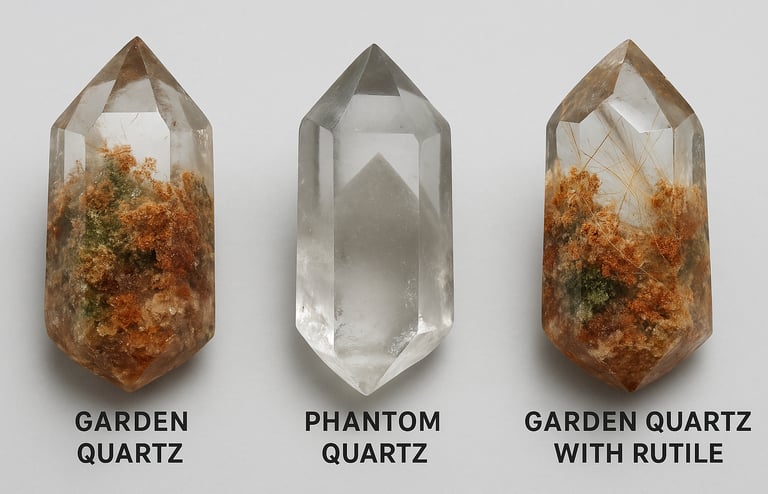

Notes
Garden Quartz is often regarded as a stone of profound spiritual connection. Beyond its physical and emotional healing properties, it is seen as a gateway for accessing deeper wisdom and guidance from the earth. Its natural inclusions allow the user to connect with the energies of nature and the Earth, offering clarity and insight during meditation and spiritual practices.
The stone is also commonly used for energy clearing. It is thought to help clear blockages in the energy field, facilitating the smooth flow of energy throughout the body. Many people use Garden Quartz to purify their environment and space, making it a popular choice for crystal grids and energy healing rituals.
Additionally, Garden Quartz is said to be a helpful companion during times of transition or change. Its energy is believed to provide support and encouragement, especially when one is moving through periods of personal growth, emotional release, or healing. Whether used for personal reflection or group work, Garden Quartz is considered a powerful tool for spiritual development and transformation.
